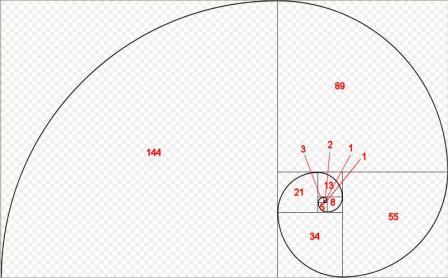|
 tart
with the number 0 and the number 1. Add them together. You get 1. Now add
that 1 to the previous 1. This time you get 2. Are we going too fast here?
Now add the 2 to the immediately preceding 1, for a sum of 3. So far, we
have produced the following series of 'natural' numbers: 0, 1, 1, 2, 3.
Continuing in like manner, adding the 3 we just computed to the 2 from
one step ago, and we get the next number in the series, 5. And so forth,
8, 13, 21,... tart
with the number 0 and the number 1. Add them together. You get 1. Now add
that 1 to the previous 1. This time you get 2. Are we going too fast here?
Now add the 2 to the immediately preceding 1, for a sum of 3. So far, we
have produced the following series of 'natural' numbers: 0, 1, 1, 2, 3.
Continuing in like manner, adding the 3 we just computed to the 2 from
one step ago, and we get the next number in the series, 5. And so forth,
8, 13, 21,...
|
0, 1, 1, 2, 3, 5, 8, 13, 21, 34,
55, ...
|
These numbers form the 'Fibonacci Sequence.' Its discovery
dates back to the early thirteenth century and to the most distinguished
mathematician of the Middle Ages, Leonardo
Fibonacci, also known as Leonardo of Pisa. He invented the first 'recursive
number sequence.'
 ver
the centuries, countless mathematicians have devoted their careers to the
study of such integer sequences, discovering esoteric properties in them.
Philosophers have joined in the fun, writing recondite monographs to one
another about the mystical attributes of Fibonacci numbers. ver
the centuries, countless mathematicians have devoted their careers to the
study of such integer sequences, discovering esoteric properties in them.
Philosophers have joined in the fun, writing recondite monographs to one
another about the mystical attributes of Fibonacci numbers.
Today's number theorists and computer scientists continue
the arcane tradition. As recently as 1962, a group of enthusiasts founded
'A Fibonacci Association' -- in California, of course.
Fibonacci numbers grow big fast. The 41st entry in the
series amounts to more than 100 million. You can prove that for yourself
in just a few minutes.
|
Given that...
...is a Fibonacci number.
|
|
What is the next number in sequence?
|
GO TO SOLUTION PAGE

|

